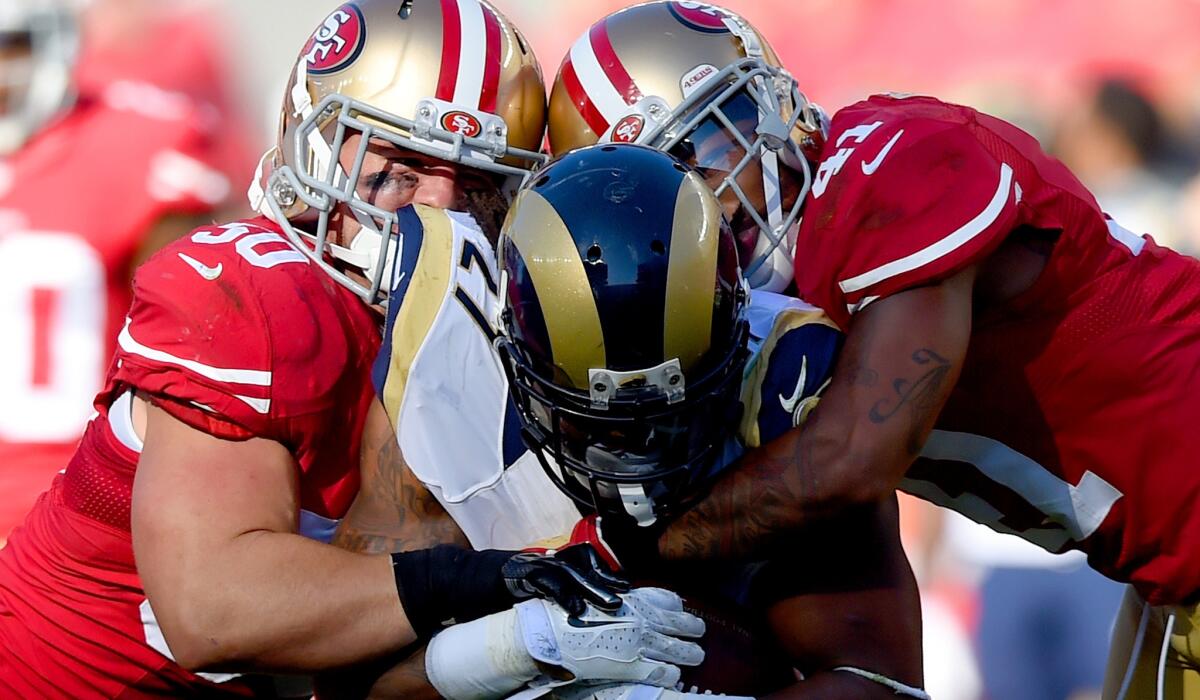Chris Borland’s early retirement shifts focus of head injuries in NFL

- Share via
Of all the tumult to follow the National Football League in the past year — including a spate of domestic violence cases and questions about deflated footballs — nothing has roiled the country’s most popular sport quite like the retirement of an unheralded San Francisco 49ers linebacker.
Chris Borland wasn’t a household name. That changed Monday when the 24-year-old walked away from a four-year $2.9-million contract because of concern about the long-term health risk of playing football.
Within hours, Borland was transformed into a new face of a league that generates $9 billion in annual revenue and accounted for 45 of the 50 most-watched television shows last fall. He is young and healthy and known for on-field toughness. His best years and biggest paychecks were in front of him. But Borland decided that football’s potential consequences loomed larger than millions of dollars.
“It’s a decision that should wake up the powers that be,” said Gary Plummer, an NFL linebacker for 12 seasons who is in the early stages of dementia. “I think the retirement of a young, up-and-coming player should be a watershed moment for the NFL that something needs to be done for the safety of the game.”
Earlier this year, an NFL-commissioned study projected that about one in three retired players would develop a serious neurocognitive condition. At least six players are living with Lou Gehrig’s disease. Another nine have killed themselves since 2010. And the brains of 76 of 79 deceased retired players examined at Boston University showed signs of chronic traumatic encephalopathy, a devastating neurodegenerative disease.
Yet the NFL, which says that concussions declined by 25% during the 2014 season, is more popular than ever.
“I just don’t want to get in a situation where I’m negotiating my health for money,” Borland told ESPN’s “Outside the Lines.” “Who knows how many hits is too many?”
Borland’s retirement shifted the focus from retired players with broken bodies and battered minds to someone at the start of a lucrative career.
Three other NFL players 30 and younger — Jake Locker, Patrick Willis and Jason Worilds — retired in recent weeks. None cited concerns about brain injury, as Borland did. None boasted the same combination of youth and ability, either.
“He came to a decision that most of us thought about but never had the courage to act on,” said Scott Fujita, an 11-year NFL linebacker who retired in 2012.
Fujita considered retiring after sustaining a concussion — only his wife knew about the injury — during the New Orleans Saints’ Super Bowl win over the Indianapolis Colts in 2010. The injury left Fujita dazed for four or five weeks. Quitting the game, though, proved too difficult.
“Essentially I chickened out,” he said.
While Fujita remembers “cobwebs” from the concussion, Borland experienced a “fog” after a preseason collision with a teammate during a practice last year. The moment proved to be pivotal for a man who graduated from the University of Wisconsin with a history degree and the 49ers invested a third-round draft pick in.
“That play was the realization of what could happen if I did this for a long time,” Borland told ESPN.
After experiencing his symptoms, Borland told his parents in a letter that his first NFL season could also be his last. Borland made 107 tackles and intercepted two passes as he started eight games and became a key member of the 49ers’ defense.
All the while, he knew the time on the field would be short.
Would-be tipping points in the long national debate over football’s safety have come and gone. Ray Easterling, part of the first federal concussion lawsuit against the league filed in 2011, killed himself in 2012. Weeks later, former San Diego Chargers linebacker Junior Seau shot himself in the chest with a .357-caliber Magnum. Both retired players were later diagnosed with CTE.
“When people in your chosen profession shoot themselves in the chest, it causes you to be taken aback,” Borland told ESPN. “Again, you may be able to play for a long time and be healthy, but it caused me to pause and think.”
Whether Borland’s retirement is a game-changing moment for the NFL or an outlier remains to be seen. No one expects an exodus of gifted players at the dawn of their careers to follow Borland out of the league.
“I still don’t feel like we’re at a point where players are afforded the chance to make informed decisions because the NFL refuses to share data needed to quantify the risk of playing NFL football,” said Sean Morey, who has battled post-concussion syndrome following a 10-year NFL career.
Morey played through numerous concussions. He thinks he should have retired at least a year or two earlier. But he didn’t.
“I’m still suffering the effects,” he said.
Chris Nowinski, executive director of the Sports Legacy Institute that studies brain trauma in athletes, believes that more football players in high school and college will choose to drop the sport.
Half of the respondents to a Bloomberg Politics poll released in December don’t want their sons to play football.
“If Chris Borland won’t take a half-million dollars a year to get hit in the head, parents should be asking why am I putting my 7-year-old out there,” Nowinski said. “He can understand the risk.”
Plummer agrees that the ripples from Borland’s choice could come in less visible places.
“It’s not going to be the domino that falls and topples the game,” Plummer said. “But I think it’s going to cause mothers that are afraid to allow their little boys to play Pop Warner and high school football ... to convince their husbands that, no, he is not going to play football.”
Fujita warns against the temptation to view one player making one decision as a transcendent moment for the sport. On the other hand, nor does he believe that football’s popularity will be the same 20, 30 years from now.
“My mom said that if she could go back and do it all over again she wouldn’t let me play,” Fujita said.
The NFL, though, rolls on.
Last month’s Super Bowl between the New England Patriots and Seattle Seahawks was the most-watched program in television history. Thirty-second ad spots sold for $4.5 million. Months of controversy and questions about the league had no discernible effect on the year’s most anticipated sporting event.
“The whole enterprise of football has become such a big part of our lives,” said Ed Hirt, a psychology professor at Indiana University who studies sports fandom. “It’s something that’s going to be incredibly difficult to kill or undermine in any way because we’re so forgiving.
“Life is not the same without it.”
Twitter: @nathanfenno
Times staff writer Sam Farmer contributed to this report.
More to Read
Go beyond the scoreboard
Get the latest on L.A.'s teams in the daily Sports Report newsletter.
You may occasionally receive promotional content from the Los Angeles Times.










